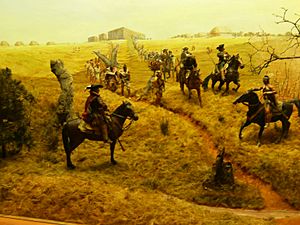James Moore (governor) facts for kids
Quick facts for kids
James Moore
|
|
|---|---|

A depiction of Moore during the Apalachee massacre in the Ocmulgee Mounds National Historical Park
|
|
| Governor of Carolina | |
| In office 11 September 1700 – March 1703 |
|
| Monarch | William III Anne |
| Preceded by | Joseph Blake |
| Succeeded by | Nathaniel Johnson |
| Personal details | |
| Born | c. 1650 England |
| Died | 1706 (aged 55–56) |
James Moore (c. 1650 – 1706) was an important leader in the early history of the Carolina colony. He was born in England around 1650 and later became a military officer and a colonial governor.
Moore served as the governor of Carolina from 1700 to 1703. He is most famous for leading several attacks into Spanish Florida during a conflict called Queen Anne's War. These attacks, especially in 1704 and 1706, destroyed many Spanish missions in Florida. During these campaigns, he also captured thousands of Apalachee people, who were then taken to Carolina as enslaved people.
Contents
Early Life and Career
Not much is known about James Moore's early life. Some people believed he was the son of an Irish military officer named Sir Rory O'Moore.
Moore first appeared in Carolina records in 1675. He quickly became involved in the colony's government.
- In 1677, 1682, and 1683, he was a member of the provincial council.
- In 1690, he led an expedition across the Appalachian Mountains. His goal was to explore trade opportunities with Native American groups.
- In 1698, he was elected to the provincial assembly.
- In 1699, he became the chief justice of the province. He held this job until he was named governor in 1700.
Moore was a leader of a political group in Carolina called the "Goose Creek Men." This group was named after Goose Creek, an area outside of Charleston. In 1683, Moore was given about 2,400 acres of land by the lords proprietor, who owned the colony. He named his estate "Boochowee."
Governor of Carolina
When James Moore became governor in 1700, it marked a big change in Carolina politics. His group, the "Goose Creek Men," took power from another group called the "Dissenters." The lords proprietor supported Moore, making it clear that the Dissenters were no longer their favorites.
During his time as governor (1700-1703), Carolina was in the process of splitting into North and South Carolina. Moore led several attacks from Carolina into Spanish Florida. He often relied on Native American allies, especially the Yamasee people, for his military forces.
Attacks on Spanish Florida
In 1702, when Queen Anne's War began, Moore led an invasion of Spanish Florida. He had 500 colonists, 300 Native American allies, and 14 small ships. They attacked along the coast, destroying Spanish missions and the lands around St. Augustine. The town of St. Augustine was burned, but the main fort, Castillo de San Marcos, held strong. Many Spanish people and their Native American allies took shelter inside the fort. Moore's forces could not capture the fort. This campaign was seen as a failure because the fort was not taken and it cost a lot of money. Moore then resigned as governor.
In 1704, Moore led another expedition into western Florida. This time, he had 50 colonists and 1,000 allied Native Americans, including Muscogee and Yamasee warriors. This campaign led to the Apalachee massacre. The Apalachee were the last strong Native American group allied with the Spanish in that area. After their defeat, many Apalachee people were enslaved and taken to Carolina or the West Indies. Others were moved to the Savannah River. This defeat also weakened the defenses of other Native American groups in Florida. In the years that followed, slave raiders from Carolina and their Native American allies nearly wiped out the Native American population in Florida, all the way to the Florida Keys.
Moore's victory over the Apalachee was a big win for Carolina. It helped strengthen the ties between various southeastern Native American groups and Carolina. The Creek and Cherokee nations became much closer allies with Carolina. With these strong alliances, the English gained more power than the French and Spanish in the American southeast.
James Moore died in 1706 from a tropical disease, possibly yellow fever.
Family Life
James Moore married Margaret Berringer. They had ten children. Many of their children later moved to the Lower Cape Fear region. There, they and their descendants became known as "The Family," a very powerful family in that area.
Moore was the grandfather of Continental Army Brigadier General James Moore. He was also the great-grandfather of Continental Army Major General Robert Howe.
The Moore family owned many large farms and plantations in the Carolinas, especially in the Cape Fear area. They brought many enslaved African people to work on these lands. James Moore also had homes in Charleston and near Goose Creek.
Another descendant of the Moore family, Alfred Moore, later became a Justice of the U.S. Supreme Court.
Family Tree
Nathaniel Moore (son of Rory Oge O'More)
| Margaret Berringer | James Moore | ||||||||||||||||||||||||||||||||||||||
| Maurice Moore | Mary Porter | Colonel James Moore | |||||||||||||||||||||||||||||||||||||
| James | John Ashe | Rebecca | Maurice | James Moore | |||||||||||||||||||||||||||||||||||
See also
 In Spanish: James Moore (político) para niños
In Spanish: James Moore (político) para niños

